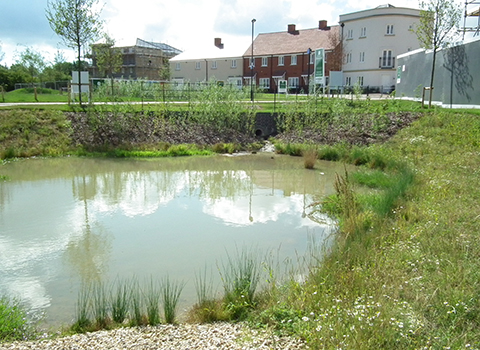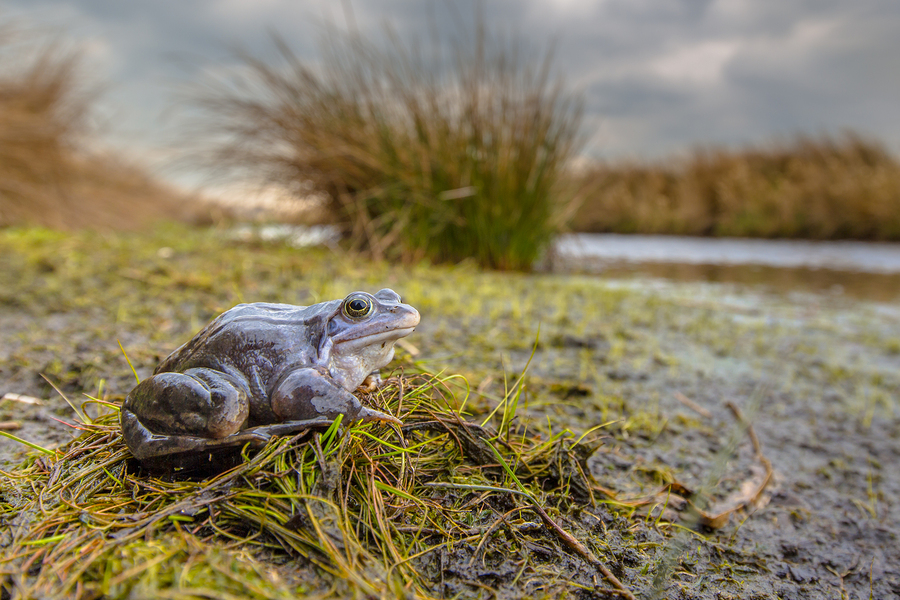What Is Sustainable Drainage?
Sustainable Urban Drainage Systems (or SUDS for short) mimic the natural drainage patterns in a development as far as possible, to alleviate flooding and reduce associated pollution during heavy or prolonged rainfall.
To illustrate this, let’s compare how the drainage system serving a hard paved surface responds compared to that of a natural green space.
Firstly, when rain falls on a green space, such as a field, woodland or even garden, it stays in situ for a while. It soaks into the ground, it evaporates into the atmosphere or gets absorbed by vegetation. If it ends up flowing into a river or stream, its passage is slowed down and the volume draining to the river is far lower than the volume that originally fell as rain. Plus, the vegetation also helps to filter out pollutants so the runoff is cleaner.
Conversely, when rain falls onto a hard surface, it flows away much more quickly. Drainage systems of gullies and pipes collect this water and transport it away as quickly as possible to the nearest river or stream. It doesn’t soak into the ground, or get absorbed by vegetation, so the volume leaving the site is far greater. It is also untreated, so any pollution in the water is carried with it.
We can compare the runoff from a hard surface to that from a green surface diagrammatically as follows:

If Q is the flow running off the site, t is time, peak flow is the highest point on the curve and the total volume of runoff is the area under the curve. Then we can see that both the peak flow and the total volume of runoff for a hard surface tend to be higher than for a green surface.
Why Do We Need Sustainable Drainage?
As our towns & cities have grown over the years, more & more pipes pass more & more flow into our streams & rivers, many of which cannot cope with these additional flows. The result is flooding downstream, erosion, destruction of delicate river habitats and pollution. It also reduces the amount of water soaking into the ground & recharging the underground aquifers, which means less water is available to supplement the rivers in times of drought and leads to water shortages.
Which is where sustainable drainage comes in. As I said earlier, SUDS mimic the natural drainage patterns in a development as far as possible, to alleviate flooding and associated pollution during heavy or prolonged rainfall. Essentially, we are trying to turn the blue line on the curve above into the red line.
Key Concepts Behind Sustainable Drainage
The key concepts behind SUDS are that:
- Rainwater should be encouraged to soak into the ground wherever possible;
- Surface water run-off from a development should be as free from pollution as possible;
- Rate of flow of surface water run-off should not be greater than that for an equivalent undeveloped area.
Remember, we are trying to turn the blue line on the curve above into the red line.
Sustainable Drainage Techniques
SUDS systems use a variety of techniques to control surface water run-off. We can provide any number or combination of the following:
- Soakaways and Other Infiltration Devices – these are essentially underground structures, sized to store water from a rainfall event that is then allowed to soak into the ground naturally;

- Permeable Surfaces or Paving – these allow the rainwater to pass through the surface into the subbase beneath, where it is stored and again allowed to soak into the ground, unlike traditional paving which is impervious and needs a system of gullies and pipes to channel flow into the sewers. Permeable paving allows these gullies & pipes to be eliminated or much reduced. It also removes pollution by filtering out fine particles in the water;

- Filter Strips and Swales – these are areas of ground, covered in vegetation, that absorb runoff from adjacent hard surfaces. Filter strips are flatter, while swales resemble long shallow ditches, and are often used to carry the collected water elsewhere. They slow down the flow of surface water and remove pollutants as the flow is filtered by the planting;

- Above Ground Storage & Flow Balancing – is provided by basins and ponds. They can be either dry or wet, with the water level fluctuating to store runoff and flows going out controlled with a specially engineered device to reduce flooding. By retaining water and use of planting, they can remove pollution. They can also be an important amenity feature on a site, as well as providing much-needed habitat and biodiversity;

- Below Ground Storage & Flow Balancing – is provided by large pipes, culverts or tanks, with the outflow again controlled to reduce flooding. They don’t provide any amenity value or reduce pollution as the above ground features do, but they take up much less space and so are often the preferred solution for developers.

Further Information
That is a very brief introduction to sustainable drainage and some of the techniques that can be used to reduce the negative impact of a development on the surrounding environment. Much more information can be found on the Susdrain website.
SP Civil Design’s specialism is water and environmental civil engineering, with a focus on sustainability. If you would like to discuss a potential project with us, or have any comments or questions about this article, then please get in touch via our Contact section or email [email protected].







